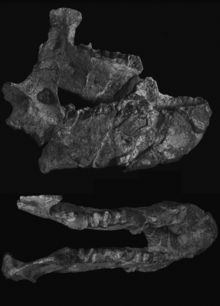Obergfellia
| Obergfellia Temporal range: middle Eocene | |
|---|---|
 | |
| Two views of a lower jaw | |
| Conservation status | |
| Fossil | |
| Scientific classification | |
| Kingdom: | Animalia |
| Phylum: | Chordata |
| Class: | Mammalia |
| Order: | Perissodactyla[1] |
| Family: | †Anthracobunidae |
| Genus: | †Obergfellia Cooper et. al., 2014 |
| Species | |
| |
Obergfellia is an extinct genus of stem perissodactyl from the middle Eocene, discovered in 1980. Its known range includes northern India and Pakistan.[1]
Cooper et al. (2014) erected the genus using specimens formerly assigned to Anthracobune and Pilgrimella. It is named in honor of the late married vertebrate paleontologists Friedlinde Obergfell and A. Ranga Rao.[1]
The suite of features that distinguish it from other anthracobunids are broad lower molars, short lower m3, and a fairly long angular process of the mandible, but not as long as in Anthracobune.[1]
References
- ↑ 1.0 1.1 1.2 1.3 1.4 Cooper, L. N.; Seiffert, E. R.; Clementz, M.; Madar, S. I.; Bajpai, S.; Hussain, S. T.; Thewissen, J. G. M. (2014-10-08). "Anthracobunids from the Middle Eocene of India and Pakistan Are Stem Perissodactyls". PLoS ONE 9 (10): e109232. doi:10.1371/journal.pone.0109232. PMID 25295875.
